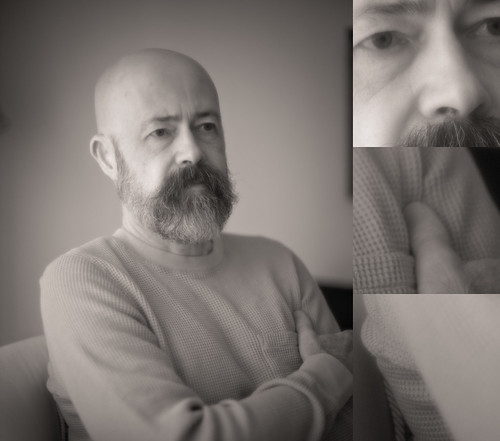I'll admit it up front. I lied. I decided I needed to have two more blog entries. Part Eight is not, repeat, not the last in the series. There. Truth in Advertising. And all that. Now that I've gotten that out of the way, onward.
Years ago I learned that soft focus photography tried to make images look more "artistic." One of the challenges in the US back in the early days of photography was that "straight", "sharp" figure photography was unlawful. In fact, in my lifetime a person could go to jail for making and having such works in their collection.
To get around this, late-1800's/early-1900's American photographers used soft focus lenses. They were able to successfully claim that these kinds of images were "art." I learned this interesting historical tidbit from reading "Clarence White and his world."
Sometime in the mid to late-1960's an English photographer built an enormous body of work and quite a career that was partly based on soft imaging effects. In the case of David Hamilton he used light dustings of hairspray on otherwise clear lens filters (think UV filters). Certainly he didn't use these DIY filters on every image he ever made, but when he used them, something rather special was possible. The approach predates by several decades the current Cinebloom/Tiffen Pro-Mist filter approach.
The soft filter images are different than those made using deliberately designed soft focus lenses. In general, "soft" filters in front of a fully corrected optic can give a "glow" effect, while retaining the basic optical corrections of the lens. Have a look at the lit signage in this Wes Anderson video short to see how this might be seen. These kinds of "glowy" filters appear to be popular with film photographers these days as well.
I happen to have an old Nikon Nikkor Soft filter set. The Nikkor Soft filters come in #1 and #2 strength. I find the #2 filter to be a bit to over the top strong for my tastes. So I tend to stick with the still somewhat strong #1.
If you'll recall, I posted something on image processing and using global, local, and sometimes micro-contrast controls to try a reveal any sense of underlying sharpness. That post talked only about pulling sharpness out of a Pentax 85mm f/2.2 Soft.
For this blog entry I would like to try the same image processing approach on a Nikon Nikkor Soft #1 filter. I put the filter in front of an early Nikon Nikkor-S 50mm f/1.4 pre-Ai that was shot wide open. I thought it might be interesting to see what happened when I coupled the Nikkor Soft #1 with a narrow depth of field and to use the power of digital image processing.
Just for grins, I also made a nose-greased image. I applied a little nose grease to a UV filter to see how that might compare to the Nikkor Soft #1.
Setup ~
- Camera -
- Sony A7, 100ISO, 2sec timer, "A" mode
- Lens -
- Nikon Nikkor-S 50mm f/1.4 at f/1.4
- Nikon Nikkor Soft #1 filter
- UV filter + nose grease (lightly applied)
- Bogen tripod
- RawTherapee -
- Global Contrast increased to taste
- Local Contrast increased to taste
- Micro Contrast set to maximum when used
Comparison
As always, click on the image and enlarge to 100percent to see whatever there is to be seen.
Base Image
No filter
From wide open I can see that the old Nikon Nikkor-S 50mm f/1.4 is a fine optic. Image rendition is consistent across the field. There are no obvious optical defects.
Base Image +
Nose Greased UV filter
It is clear that nose grease works to soften the contrast and make the highlights "glow." The process of smearing nose grease on a UV filter is easily controllable. This can be used to control the "strength" of the effect.
For image processing I increased the global contrast, and I set the local contrast sliders to something that I felt balanced the tones without making the processed image look too "artificial."
Base Image +
Nikon Nikkor Soft #1 filter
It's interesting to compare the Nikkor Soft filtered image to the UV nose-greased photo. I modified the global and local contrast to make what I felt looked like a decent image. I'm sure I could increase the local contrast, particularly around the eyes, to make the image *pop* a bit more. As a starting point to compare softening filters and unfiltered images, I think this is sufficient.
It's interesting to see how managing contrast effects softened images. This is the control David Hamilton used, though he might not have fully appreciated it at the time. It's been written that M.Hamilton had his slide film push processed. This increased grain (which also enhances an "artistic" effect) and increased contrast (which I've tried to emulate here).
Nikon Nikkor-S filtered images lack the optical deformities of a true soft focus lens. Of course the softening effect is controlled differently. I can imagine that a photographer might choose one approach over another, filtered over optical soft focus, depending on subject, lighting, and composition.
I have to admit, though, that in this series of blog entries I might be over-thinking the whole thing a little too much. Most of us react emotionally to a scene, don't we? Maybe it's a Gud Thing(tm) that I'm considering this from a rational perspective outside live photography situations. Can I apply rational experience in an emotional setting? Hmmm... now there's yet another dimension to all this softness to consider...



No comments:
Post a Comment